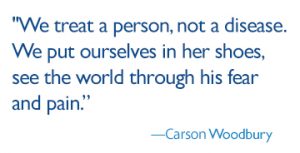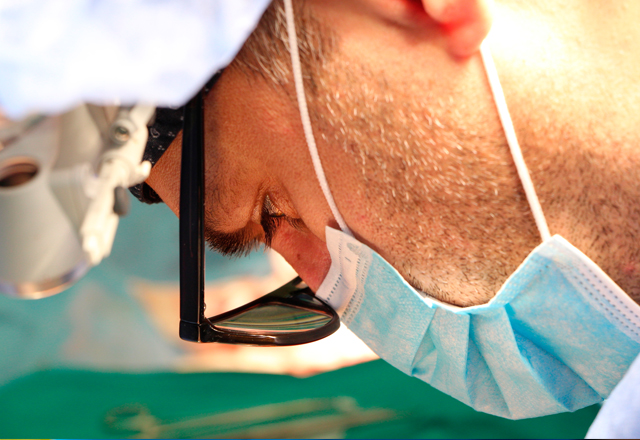The first time, you don’t realize how warm his body will be. On some level, you knew the patient’s temperature would be in the range of 98.6 degrees Fahrenheit; his skin, just a few degrees below that. But somehow that information never registered with your fingertips. As you feel the tissue around his wound, palpating for the invisible lines of tension pulling apart its edges, your fingers surprise you. They register warmth, movement, life. Your mind, racing ahead to selection of the suture material, appropriate knot technique and needle placement, is quietly reminded: This man is alive. This man is a person. And you are about to sew his skin like torn denim.
As a second-year medical student, I’ve spent years using suture techniques to repair my ripped jeans and frayed sleeves. I’ve practiced mattress sutures using orange peels and placed subcutaneous stitches into pigs’ feet, but I am only now beginning to close patients’ wounds in the hospital. It’s a very different experience when the target of your needle can feel and think and tell you how much he loves Tom Hanks movies.
On one hand, I remain awed by the unique humanity of my patient: He has a family, a favorite film, dreams and aspirations for the future. On the other hand, to help him, I must concentrate on the biomechanics of the 6 square inches of skin and the curved steel needle immediately in front of me. I continue to be challenged by these discordant principles: How do physicians balance caring for each patient as an individual while maintaining the intense, narrow focus required to perform at the highest level?
To best care for the patient, physicians and medical students need to care about the patient. We treat a person, not a disease. We put ourselves in her shoes, see the world through his fear and pain. This intimate understanding shapes every element of the medical relationship and drives physicians’ compulsion to deliver the best possible treatment.
Embracing the patient’s humanity at the wrong time, however, can cripple a doctor’s ability to help. Consider a neurosurgeon tasked with removing a tumor from a man’s spinal cord:
Doctor, dissect the tumor away from the fasciculus cuneatus.
This statement is a clear, technical description of the operation’s objective. Now consider the same procedure communicated differently:
Doctor, cut the cancer away from the neurons that let Jim feel the warmth of his daughter’s hand.
 Can the physician begin to operate with that thought echoing through his or her mind? Compassion mobilizes our hearts, but it can also paralyze our hands. It may sound callous, but during the operation, walling off the part of the brain that sees the patient as Jim, a father, can allow the surgeon to focus on the complex challenge of separating cancer from healthy spinal cord. By temporarily reducing the patient to his anatomy, physicians can incise, inject, staple and stitch with precision and a steady hand.
Can the physician begin to operate with that thought echoing through his or her mind? Compassion mobilizes our hearts, but it can also paralyze our hands. It may sound callous, but during the operation, walling off the part of the brain that sees the patient as Jim, a father, can allow the surgeon to focus on the complex challenge of separating cancer from healthy spinal cord. By temporarily reducing the patient to his anatomy, physicians can incise, inject, staple and stitch with precision and a steady hand.
Is the answer this simple? Are we as medical students expected to care deeply for our patients at all times until a sharp instrument is needed and then promptly disconnect our brains from our hearts? I don’t think so. Humanity is not a light switch to be turned on and off at will. Compassion seeps through whatever mental barriers we construct, imbuing every movement of the instruments with the respect and kindness we feel for the person before us.
You feel the warmth of your patient’s skin and know you will not sew him up like denim. He is not made of fabric. He is made of tissue — delicate, vulnerable and the anatomical building block of this Baltimore man who is looking forward to watching Apollo 13 with his wife this weekend. You begin to sew.
Related Content
- A day in the life of a medical student: the Important Role of Caregivers in Health Care
- Learn how Johns Hopkins inHealth is continuing to explore and develop individualized precision medicine approaches that will lead to quicker diagnoses, improved treatment and better outcomes.

Wow, that was a very captivating piece. I am so proud that the world has very loving people like doctors. I aspire o be one but the thought of cutting into someone at the moment is quite horrific. However, I am grateful for the article I've just read, it gave me so much more enthusiasm to go after my dream Job, more like my dream method of outreach. Thank You for the motivation.
Comments are closed.